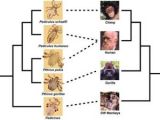A DNA analysis of pubic lice, aka "crabs" revealed that the parasites were transferred from gorillas to early humans about 3.3 million years ago.
This points to a close contact between our ancestors and gorillas, but it is far more likely that early humans got the lice from sleeping in abandoned gorilla nests or eating them than from having sex with gorillas. "It certainly wouldn't have to be what many people are going to immediately assume it might have been, and that is sexual intercourse occurring between humans and gorillas," explained researcher David Reed of the Florida Museum of Natural History. "Instead of something sordid, it could easily have stemmed from an activity that was considerably more tame."
Humans are unique among primates hosting two different kinds of lice: one on our heads and bodies (Pediculus) and pubic lice (Pthirus). By comparison, chimpanzees have only head lice and gorillas only pubic lice. "The fact the lice took up residence where they did may have coincided with human loss of most hair on the rest of their bodies and the lack of any other suitable niche to live," said Reed.
The pubic lice lives in the pubic hairs and inflict irritating spots on the skin when they feed on the blood of their hosts. Lice lack wings and cannot jump like fleas, so they remain bound to their host until they come into close contact with another individual and each species of pubic lice is specific to only one host species.
The researchers from the University of Florida in Gainesville collected Pthirus gorillae lice from gorillas in Ugandan wildlife sanctuaries. The team then analyzed the DNA of these parasites, comparing it with the mutations found in the human crab, Pthirus pubis.
Human-chimp branch is believed to have split from the common ancestor to gorillas about 7 million years ago.
As mutations accumulate at a constant pace over time, the researchers expected substantial differences between them. "Our own history is written in the DNA of parasites as well as ourselves, and by studying both we can come to a better, more complete understanding of our evolutionary history," said Reed. "These lice really give us the potential to learn how humans evolved when so many parts of our evolutionary history are obscure. Investigating lice can also help in understanding how parasites move from one species to another".
But the DNA analysis found the genes of Pthirus gorillae and Pthirus pubis surprisingly similar, pointing to a divergence of just 3.3 million years ago.
The team rather suspects that early humans could have picked up pubic lice from scavenging on gorilla corpses or sleeping in the abandoned sleeping nests of gorillas, rather than through having sex. Pubic lice can survive for up to 24 hours once removed from their host. "I don't know if we'll ever be able to know for certain which hypothesis is correct", said Reed.

 14 DAY TRIAL //
14 DAY TRIAL // 
